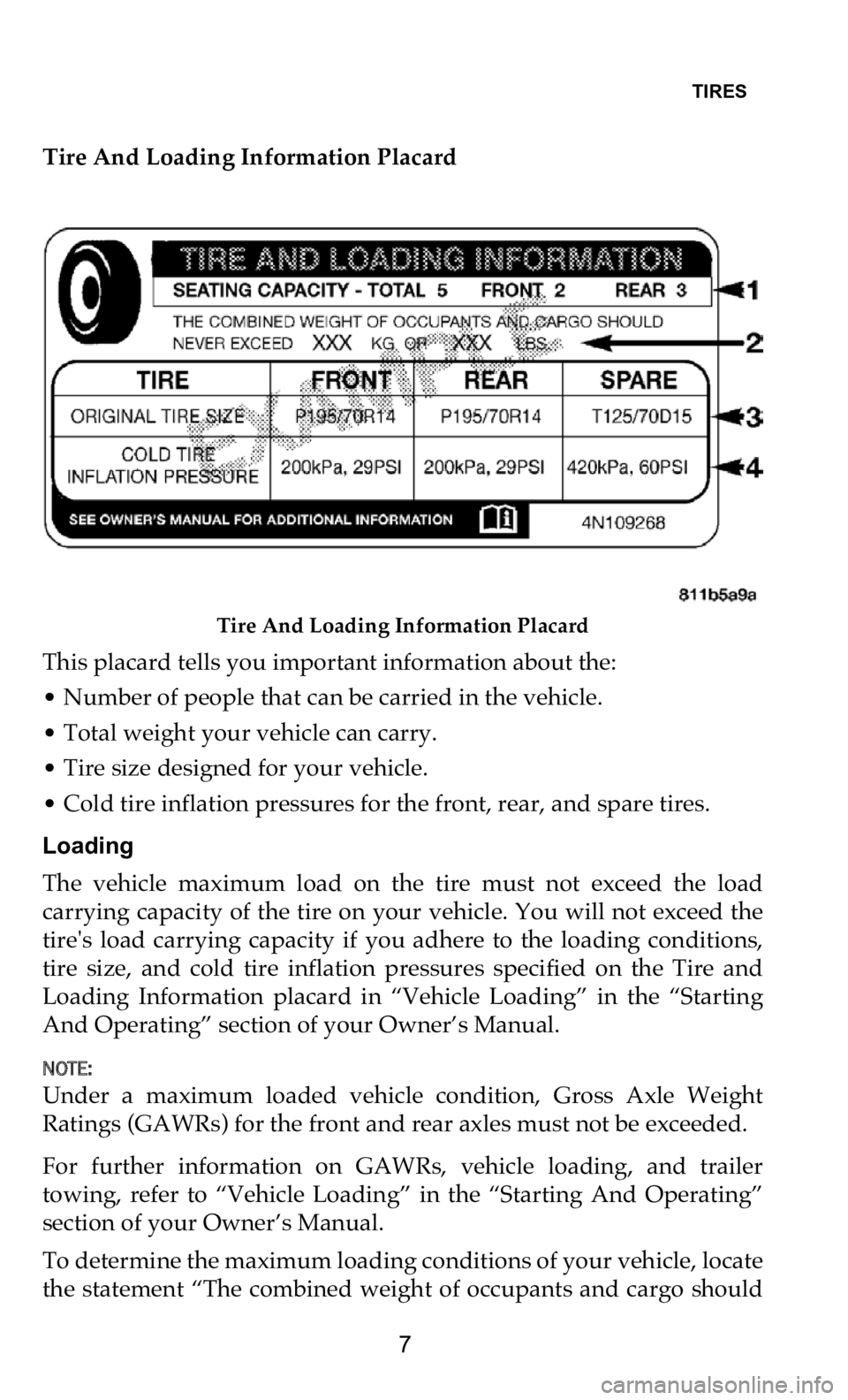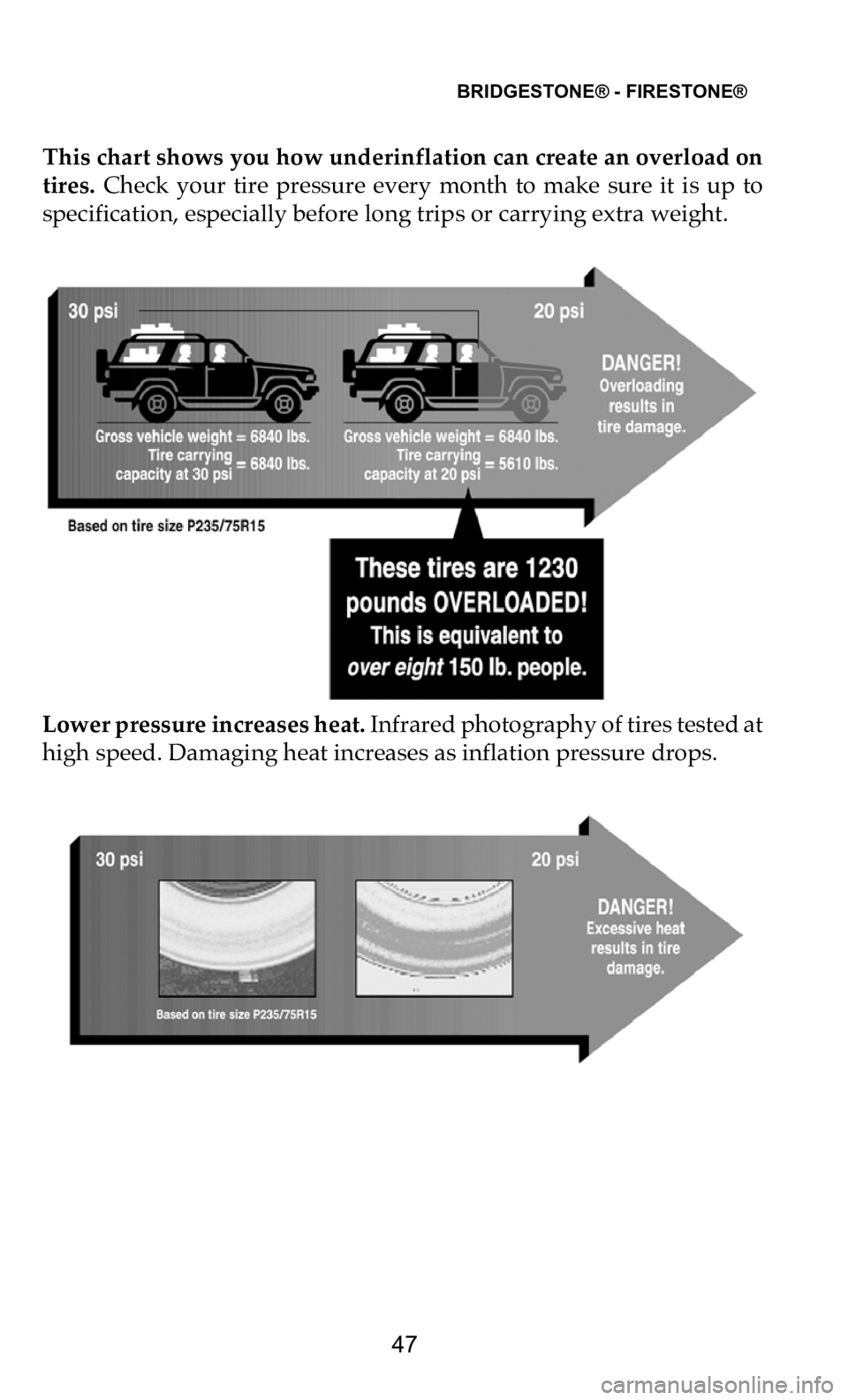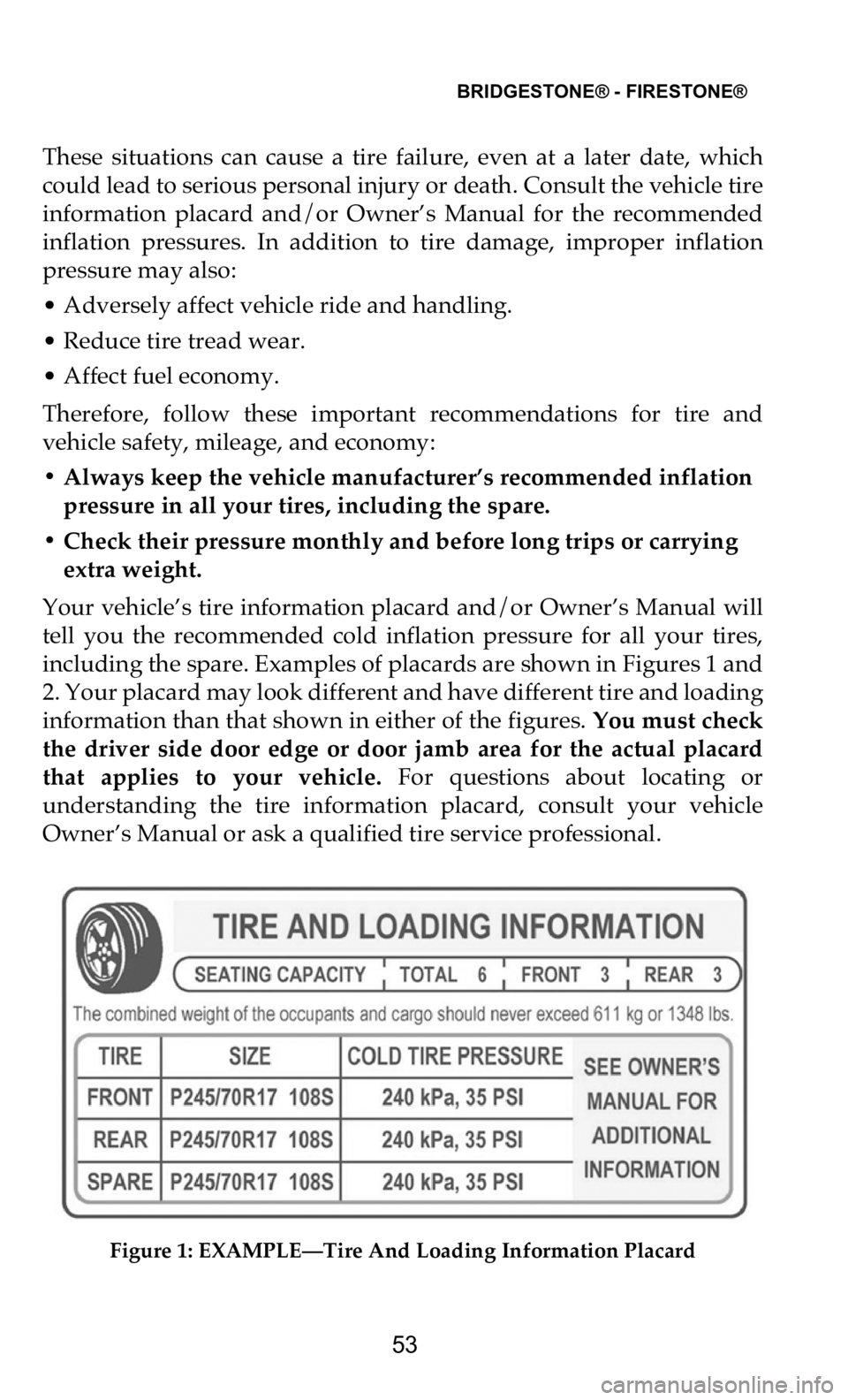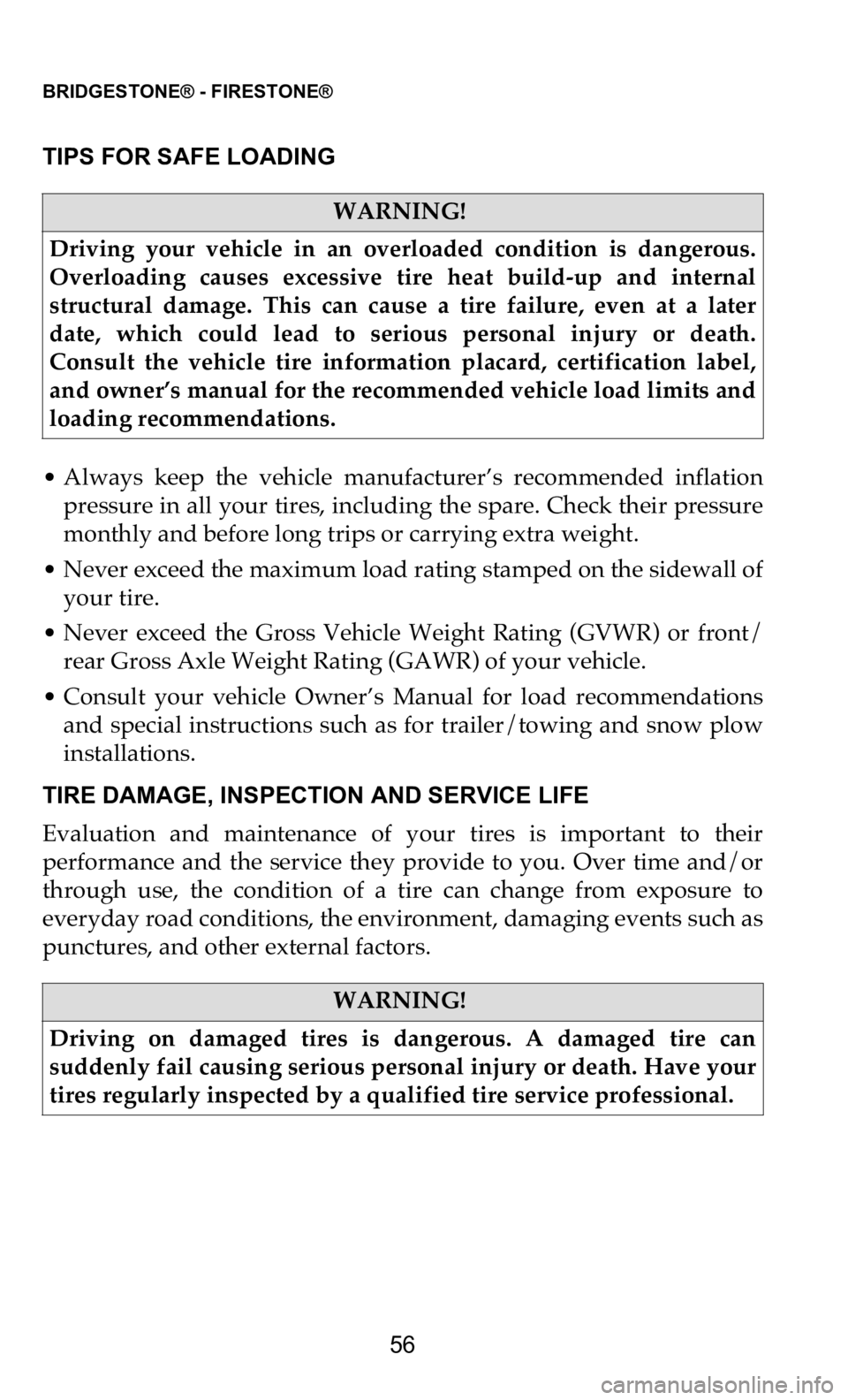weight DODGE DURANGO 2021 Vehicle Warranty
[x] Cancel search | Manufacturer: DODGE, Model Year: 2021, Model line: DURANGO, Model: DODGE DURANGO 2021Pages: 262, PDF Size: 10.42 MB
Page 8 of 262

TIRES
7
Tire And Loading Information Placard
Tire And Loading Information Placard
This placard tells you important information about the:
• Number of people that can be carried in the vehicle.
•
Total weight your vehicle can carry.
•
Tire size designed for your vehicle.
•
Cold tire inflation pressures for the front, rear, and spare tires.
L
oading
The vehicle maximum load on the tire must not exceed the load
ca
rrying capacity of the tire on your vehicle. You will not exceed the
tire's load carrying capacity if you adhere to the loading conditions,
tire size, and cold tire inflation pressures specified on the Tire and
Loading Information placard in “Vehicle Loading” in the “Starting
And Operating” section of your Owner’s Manual.
NOTE:
Under a maximum loaded vehicle condition, Gross Axle Weight
Ra
tings (GAWRs) for the front and rear axles must not be exceeded.
For further information on GAWRs, vehicle loading, and trailer
to
wing, refer to “Vehicle Loading” in the “Starting And Operating”
section of your Owner’s Manual.
To determine the maximum loading conditions of your vehicle, locate
th
e statement “The combined weight of occupants and cargo should
Page 9 of 262

TIRES
8
never exceed XXX kg or XXX lbs” on the Tire and Loading Information
placard. The combined weight of occupants, cargo/luggage and
trailer tongue weight (if applicable) should never exceed the weight
referenced here.
Steps For Determining Correct Load Limit:
(1) Locate the statement “The combined weight of occupants and
ca
rgo should never exceed XXX kg or XXX lbs.” on your vehicle's
placard.
(2) Determine the combined weight of the driver and passengers that
wi
ll be riding in your vehicle.
(3) Subtract the combined weight of the driver and passengers from
XX
X kg or XXX lbs.
(4) The resulting figure equals the available amount of cargo and luggage
lo
ad capacity. For example, if “XXX” amount equals 1,400 lbs. and there
will be five 150 lb passengers in your vehicle, the amount of available
cargo and luggage load capacity is 650 lbs. (1,400-750 (5x150) = 650 lbs.)
(5) Determine the combined weight of luggage and cargo being loaded
on
the vehicle. That weight may not safely exceed the available cargo
and luggage load capacity calculated in Step 4.
(6) If your vehicle will be towing a trailer, load from your trailer will be
tr
ansferred to your vehicle. Consult this manual to determine how this
reduces the available cargo and luggage load capacity of your vehicle.
Metric Example For Load Limit
For example, if “XXX” amount equals 635 kg and there will be five 68 kg
pa
ssengers in your vehicle, the amount of available cargo and luggage
load capacity is 295 kg (635-340 (5x68) = 295 kg) as shown in step 4.
NOTE:
• If your vehicle will be towing a trailer, load from your trailer will be
transferred to your vehicle. The following table shows examples on
how to calculate total load, cargo/luggage, and towing capacities of
your vehicle with varying seating configurations and number and
size of occupants. This table is for illustration purposes only and
may not be accurate for the seating and load carrying capacity of
your vehicle.
• For the following example, the combined weight of occupants and
c
argo should never exceed 865 lbs (392 kg).
Page 36 of 262

BFGOODRICH® TIRES
35
DO NOT OVERLOAD - DRIVING ON ANY OVERLOADED TIRE
IS DANGEROUS
The maximum load rating of your tires is molded on the tire sidewall.
Do
not exceed this rating. Follow the loading instructions of FCA US
LLC and this will ensure that your tires are not overloaded. Tires
which are loaded beyond their maximum allowable loads for the
particular application will build up excessive heat that may result in
sudden tire destruction.
Do not exceed the Gross Axle Weight Rating (GAWR) for any axle on
yo
ur vehicle.
TRAILER TOWING
If you anticipate towing a trailer, you should visit any BFGoodrich®
ti
re retailer for advice concerning the correct size tire and pressures.
Tire size and pressures will depend upon the type and size of trailer
and hitch utilized, but in no case must the maximum cold inflation
pressure or tire load rating be exceeded. Check the tire decal and the
Owner’s Manual supplied by FCA US LLC for further
recommendations on trailer towing.
WHEEL ALIGNMENT AND BALANCING ARE IMPORTANT
FO
R SAFETY AND MAXIMUM MILEAGE FROM YOUR TIRES
CHECK HOW YOUR TIRES ARE WEARING AT LEAST ONCE
EA
CH MONTH
If your tires are wearing unevenly, such as the inside shoulder of the
ti
re wearing faster than the rest of the tread, or if you detect excessive
vibration, your vehicle may be out of alignment or balance. These
conditions not only shorten the life of your tires but adversely affect
the handling characteristics of your vehicle, which could be
dangerous. If you detect irregular wear or vibration, have your
alignment and balance checked immediately. Tires which have been
run underinflated will show more wear on the shoulders than in the
center of the tread.
TIRE MIXING
BFGoodrich® tires are radial tires and for best performance it is
r e
commended that the same size and type of tire be used on all four
wheel positions. Before mixing tires of different types in any
configuration on any vehicle, be sure to check the vehicle
manufacturer’s Owner‘s Manual for its recommendations.
Page 38 of 262

BFGOODRICH® TIRES
37
manufacturer’s specification due to the actual load on that wheel
position. Some vehicles may have different sized tires mounted on the
front and rear axles, and these different sized tires have rotation
restrictions. Always check the vehicle Owner’s Manual for the proper
rotation recommendations.
FULL-SIZE SPARE
Full-size spare tires (not temporary spares) of the same size and
co
nstruction should be used in a five tire rotation. Always check the
inflation pressure of the full-size spare immediately before
incorporating it into rotation. Follow the vehicle manufacturer’s
recommended pattern for rotation, or if not available, see a qualified
tire technician.
REPLACEMENT OF TWO TIRES
It is recommended that all four tires are replaced at the same time.
Ho
wever, whenever only two tires are replaced, the new ones should
be put on the rear. The new tires, with deeper tread, may provide
better grip and water evacuation in wet driving conditions.
CUSTOMIZATION OF TIRES, WHEELS, OR SUSPENSION ON
SU
VS AND LIGHT TRUCKS
Due to their size, weight and higher center of gravity, vehicles such as
SU
Vs and light trucks do not
have the same handling characteristics
as automobiles. Because of these differing characteristics, failure to
operate your SUV/truck in a proper and safe manner can increase the
likelihood of vehicle rollover. Modifications to your SUV/truck tire
size, tire type, wheels or suspension can change its handling
characteristics and further increase the likelihood of vehicle rollover.
Whether your SUV/truck has the original equipment configuration
for tires, wheels and suspension or whether any of these items have
been modified, always drive safely, avoid sudden, sharp turns or lane
changes and obey all traffic laws. Failure to do so may result in loss of
vehicle control leading to an accident and serious injury or death.
TIRE ALTERATIONS
Do not make or allow to be made any alterations on your tires.
Al
terations may prevent proper performance, leading to tire damage
which can result in an accident. Tires which become unserviceable due
to alterations such as trueing, whitewall inlays, addition of balancing
or sealant liquids, or the use of tire dressing containing petroleum
distillates are excluded from warranty coverage.
Page 40 of 262

BFGOODRICH® TIRES
39
code. The last three characters are numbers identifying the week and
year of manufacture. Example: “O25” means second week of the year
of decade, eg.: 1995, 1985, etc. Tires produced after July 2000 have an
additional digit to identify a given decade. For example, 2800 means
th
e tire was produced during the 28th week of 2000; 0201 during the
2nd week of 2001. If the last digits of your DOT number contain three
numeric characters consult a qualified tire technician to determine the
year and decade of manufacture.
STORAGE
Tires contain waxes and emollients to protect their outer surfaces from
oz
one and weather checking. As the tire rolls and flexes, the waxes
and emollients continually migrate to the surface, replenishing this
protection throughout the normal use of the tire. Consequently, when
tires sit outdoors, unused for long periods of time (a month or more)
their surfaces become dry and more susceptible to ozone and weather
checking and the casing becomes susceptible to flat spotting.
For this reason, tires should always be stored in a cool, dry, clean,
in
door environment. If storage is for one month or more, eliminate the
weight from the tires by raising the vehicle or by removing the tires
from the vehicle. Failure to store tires in accordance with these
instructions could result in damage to your tires or premature aging
of the tires and sudden tire failure.
When tires are stored, be sure they are placed away from sources of
he
at and ozone such as hot pipes and electric generators. Be sure that
surfaces on which tires are stored are clean and free from grease,
gasoline or other substances which could deteriorate the rubber.
(Tires exposed to these materials during storage or driving could be
subject to sudden failure.)
FOLLOW THESE MOUNTING RECOMMENDATIONS
Tire changing can be dangerous and must be done by professionally
tr
ained persons using proper tools and procedures as specified by
the Rubber Manufacturers Association (RMA).
Your tires should be mounted on wheels of correct size and type and
wh
ich are in good, clean condition. Wheels that are bent, chipped,
rusted (steel wheels) or corroded (alloy wheels) may cause tire
damage. The inside of the tire must be free from foreign material.
Have your retailer check the wheels before mounting new tires.
Mismatched tires and rims can explode during mounting. Also,
mismatched tires and rims can result in dangerous tire failure on the
Page 48 of 262

BRIDGESTONE® - FIRESTONE®
47
This chart shows you how underinflation can create an overload on
tires. Check your tire pressure every month to make sure it is up to
specification, especially before long trips or carrying extra weight.
Lower pressure increases heat. I
nfrared photography of tires tested at
high speed. Damaging heat increases as inflation pressure drops.
Page 54 of 262

BRIDGESTONE® - FIRESTONE®
53
These situations can cause a tire failure, even at a later date, which
could lead to serious personal injury or death. Consult the vehicle tire
information placard and/or Owner’s Manual for the recommended
inflation pressures. In addition to tire damage, improper inflation
pressure may also:
• Adversely affect vehicle ride and handling.
•
Reduce tire tread wear.
•
Affect fuel economy.
T
herefore, follow these important recommendations for tire and
ve
hicle safety, mileage, and economy:
• Always keep the vehicle manufacturer’s recommended inflation p
ressure in all your tires, including the spare.
• Check their pressure monthly and before long trips or carrying e
xtra weight.
Your vehicle’s tire information placard and/or Owner’s Manual will
te
ll you the recommended cold inflation pressure for all your tires,
including the spare. Examples of placards are shown in Figures 1 and
2. Your placard may look different and have different tire and loading
information than that shown in either of the figures. You must check
the driver side door edge or door jamb area for the actual placard
that applies to your vehicle. For questions about locating or
understanding the tire information placard, consult your vehicle
Owner’s Manual or ask a qualified tire service professional.
Figure 1: EXAMPLE—Tire And Loading Information Placard
Page 56 of 262

BRIDGESTONE® - FIRESTONE®
55
TIPS FOR SAFE TIRE INFLATION
• Check your tire pressures, including your spare tire, monthly and
b
efore long trips or carrying extra weight. Be sure to use an accurate
pressure gauge.
• Check inflation pressure when the tires are “cold.” Tires are consid -
e
red “cold” when the vehicle has been parked for three hours or
mo
re, or if the vehicle has been driven less than a mile at moderate
speed.
• Never release pressure from a hot tire in order to reach the recom -
m
ended cold tire pressure. Normal driving causes tires to run hotter
an
d inflation pressure to increase. If you reduce inflation pressure
when your tires are hot, you may dangerously underinflate your
tires.
• If it is necessary to adjust inflation pressure when your tires are
“
hot”, set their pressure to 4 psi (28 kPa) above the recommended
cold inflation pressure. Recheck the inflation pressure when the tires
are cold.
• If your tires lose more than 2 psi (14 kPa) per month, the tire, the
v
alve, or wheel may be damaged. Consult a qualified tire service
professional for an inspection.
• Use valve caps to keep the valves clear of debris and to help guard
a
gainst inflation pressure loss.
WARNING!
Inflating an unsecured tire is dangerous. If it bursts, it could be
hu
rled into the air with explosive force resulting in serious
personal injury or death. Never inflate a tire unless it is secured to
the vehicle or a tire mounting machine.
Page 57 of 262

BRIDGESTONE® - FIRESTONE®
56
TIPS FOR SAFE LOADING
• Always keep the vehicle manufacturer’s recommended inflation
p
ressure in all your tires, including the spare. Check their pressure
monthly and before long trips or carrying extra weight.
• Never exceed the maximum load rating stamped on the sidewall of
y
our tire.
• Never exceed the Gross Vehicle Weight Rating (GVWR) or front/ r
ear Gross Axle Weight Rating (GAWR) of your vehicle.
• Consult your vehicle Owner’s Manual for load recommendations
a
nd special instructions such as for trailer/towing and snow plow
installations.
TIRE DAMAGE, INSPECTION AND SERVICE LIFE
Evaluation and maintenance of your tires is important to their
pe
rformance and the service they provide to you. Over time and/or
through use, the condition of a tire can change from exposure to
everyday road conditions, the environment, damaging events such as
punctures, and other external factors.
WARNING!
Driving your vehicle in an overloaded condition is dangerous.
Ov
erloading causes excessive tire heat build-up and internal
structural damage. This can cause a tire failure, even at a later
date, which could lead to serious personal injury or death.
Consult the vehicle tire information placard, certification label,
and owner’s manual for the recommended vehicle load limits and
loading recommendations.
WARNING!
Driving on damaged tires is dangerous. A damaged tire can
su
ddenly fail causing serious personal injury or death. Have your
tires regularly inspected by a qualified tire service professional.
Page 72 of 262

BRIDGESTONE® - FIRESTONE®
71
RFT TIRES WITH RUN-FLAT TECHNOLOGY
If your vehicle is equipped with
Bridgestone® or Firestone® brand
RF
T tires, this chapter presents
specific maintenance and safety issues
associated with these tires that are in addition to those covered
elsewhere in this manual.
What is RFT? Run-Flat Technology tires are extraordinary tires that
ut
ilize specially designed components to temporarily support your
vehicle in the event of inflation pressure loss, such as from a
puncture. This gives you the ability to drive to a convenient and safe
location to change your tire (if equipped with a spare) or have it
inspected for possible repair or replacement.
Naturally, certain run-flat and low pressure operating limitations
ap
ply, which varies according to the specific self-supporting tire
design. Like all tires, during normal operation, they must be properly
inflated and maintained. Regardless of the design or quality, no tire is
indestructible.
RFT — How to Identify: B
ridgestone® and Firestone® brand tires are
marked on the sidewalls, near the wheel, with the RFT logo (shown
above).
RFT INFLATION PRESSURE
Like other tires, RFT tires need proper inflation pressure maintenance
fo
r safe operation and to achieve the maximum tire life and
performance. Check inflation pressures monthly and before long trips
or carrying extra weight. Use an accurate tire gauge and check
pressures when the tires are cold. Follow the vehicle manufacturer’s
recommendation for inflation pressure settings as indicated on the
vehicle tire information placard and/or in the vehicle Owner’s
Manual. Do not forget the spare, if applicable. See “Tire Inflation
Pressure” in this manual.
TIRE PRESSURE MONITORING SYSTEM (TPMS)
A functioning Tire Pressure Monitoring System (TPMS) must be used
wi
th your Run Flat tires. These tires ride so well even without inflation
pressure, the TPMS may be necessary to alert you of an inflation
pressure loss condition. When alerted, follow the instructions in your
vehicle Owner’s Manual and see “Run-Flat or Low Tire Pressure
Operation,” the following section in this manual.